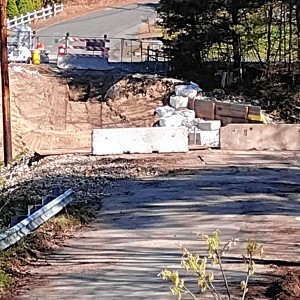Sportsman’s Corner: Water, water everywhere!
| Published: 07-06-2023 4:27 PM |
By Mike Roche
My research showed me that the famous quote can be traced back—but is actually a misquote—from “The Rime of the Ancient Mariner,” written in 1798 by Samuel Taylor Coleridge. The recent deluges have really been significant and flooding locally, across the state, the Northeast, and the entire United States has been occurring of late.
As this column is being written on Wednesday we are clear and dry, but the forecast for the next week is a concern. We just last week began the process of moving to White Pond for the summer and in two days the water level rose eight inches. With showers predicted in each day’s weather forecast from the U. S. Weather Service from Thursday until at least next Tuesday, there is cause for concern.
Those of us who have experienced cellar flooding in extremely rainy conditions have reason to be worried and local highway departments can expect to be busy with road washouts. It is certainly not good news for the many folks who chose their vacation time around the Fourth of July and outdoor work is also hindered. Mowing the lawn is becoming a regular challenge as it grows incredibly fast and mowing is influenced by rain.
On the wildlife side, the rain generally creates good fishing. Lakes and ponds have good temperatures and rain, and runoff conditions seem to provide feeding opportunities. Really heavy flows can make Deerfield River trips a problem, but other trout waters should be good. This fisherman caught a nice bass, over 18 inches long, when she was observed prowling the shadows during a shower. It was a good test for rain gear!
Speaking of which, my experiences traveling Minnesota, Alaska, Lake Ontario and Canada to fish have taught me the value of good rain gear. Frog Toggs have proven a very reliable product and a set of Cabela’s Gore-Tex breathable rain gear have also served me well. Any top brand is a good investment and you get what you pay for. My experiences at the Boundary Waters made it clear that saving a few bucks on rain gear does not seem like a good deal when rain is running down your neck and back. Even though space was a premium, this writer always brought an extra set and lent it to wet, cold campers on more than one occasion.
As for wildlife, it will be interesting to see what, if any, impact this wet spring/summer will have. As long as I can remember, the adage was that a wet, cold spring hurt recruitment for ground nesting birds. Small mammals can also suffer losses, but they are much more prolific and produce additional offspring. Hopefully, local food producers will benefit and not suffer from the extreme conditions. We can talk about the weather but cannot change it!
Bats and bat houses
Article continues after...
Yesterday's Most Read Articles
 Cryptozoology exhibits featured at Education Earth Museum
Cryptozoology exhibits featured at Education Earth Museum
 Longtime public servant Richard Sheridan dies at 78
Longtime public servant Richard Sheridan dies at 78
 Athol Royalston Middle School Honor Roll Term 3
Athol Royalston Middle School Honor Roll Term 3
 State Senate budget funds free community college for all
State Senate budget funds free community college for all
 Athol Police Logs: April 12 to April 19, 2024
Athol Police Logs: April 12 to April 19, 2024
 Work on Pinedale Avenue Bridge connecting Athol and Orange to resume
Work on Pinedale Avenue Bridge connecting Athol and Orange to resume
Many people have commented on references to bats locally. We are all aware of the significant reduction of bats due to White Nose Syndrome. An estimate of up to 90% of bats were lost. There are nine species of bats found in Massachusetts, with five listed as endangered. White Nose Syndrome, a fungal disease that impacts bats that spend their winters hibernating in caves and mines, continues to be a concern. Artificial bat houses provide clean homes for bats that are free of the syndrome.
Since 2020, MassWildlife has been working with partners and volunteers to construct, install and monitor bat houses on Wildlife Management Areas and other locations across Massachusetts. This effort provides a safe roosting place for bats and raises awareness about the important role they play in our environment. Properly constructed and strategically placed, bat houses can be an important tool in assisting bat survival.
With support from MassDOT, Scout troops, and individual volunteers, a bat house project is off to a great start and showing promising results. Some of the houses have been occupied by bats, and people are learning more about bat conservation.
You can build a bat house. Bat houses give females a safe, warm place to raise their young. Since most females only have one pup each year, bat populations grow very slowly. Additionally, due to habitat loss and degradation, it is becoming harder for bats to locate natural roosts. Installing a bat house on your property can provide a safe environment for bats, while protecting the yard from insects such as mosquitoes, moths and beetles. Bat houses can be purchased, or you can build your own. You can find a guide to bat houses on MassWildlife’s website, including plans for building a bat house, installation tips and advice for attracting bats to your bat house.
You can also create a habitat for bats, which seek shelter under peeling bark on dead trees. If you have dead or dying trees on your property, leave them standing as potential roost sites for bats. You can also create a bat-friendly landscape in your backyard by adding night-scented flowers and water features such as a pond. It is also important to reduce pesticide use. Pesticides make it difficult for bats to find healthy food to eat. Insecticides can cause bats to go hungry from the lack of insects available.
Mike Roche is a retired teacher who has been involved in conservation and wildlife issues his entire life. He has written the Sportsman’s Corner since 1984 and has served as advisor to the MaharFish’N Game Club, Counselor and Director of the Massachusetts Conservation Camp, former Connecticut Valley District representative on the Massachusetts Fisheries and Wildlife Board, has been a Massachusetts Hunter Education Instructor and is a licensed New York hunting guide. He can be reached at mikeroche3@msn.com.
]]>

 UMass student group declares no confidence in chancellor
UMass student group declares no confidence in chancellor